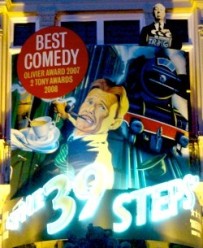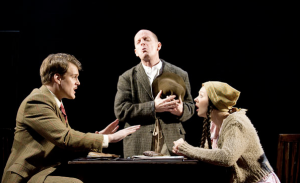‘An Inspector Calls’ Review (BRADFORD, UK)
Posted: March 15, 2012 Filed under: Stage | Tags: Alhambra, An Inspector Calls, Bradford, drama, theatre, thriller, tour, West End Leave a commentWHAT: Play (Drama/Thriller)
WHERE: Bradford Alhambra Theatre (map)
WHEN: 7th – 10th Mar, 12; check tour dates for other shows
WHO: West End touring production
WEBSITE: www.bradford-theatres.co.uk; www.aninspectorcalls.com
MY STORY IN A NUTSHELL:
- Like lots of youngsters in the country, I studied An Inspector Calls for GCSE, and so I was very excited to see it. The performance did not disappoint, although it seems to be a love/hate thing – like the marmite in theatre form.
- This West End revival is legendary director Stephen Daldry’s 1992 National Theatre debut. No one expected such success in the beginning.
- The plot revolves around the mysterious Inspector Goole interrogating each member of the wealthy and arrogant Birling family after a working class girl named Eva Smith committed suicide. As the story unfolds we learn that each of them had a part to play in her tragedy, and that ultimately ‘we are responsible for each other.’
- Visually this is an extremely striking production. Daldry daringly moved away from the traditional set, but his visions back then turned out to be as accurate in hindsight. Very well cast, too.
- A powerful and still relevant piece of theatre that cannot be ruined despite the incessant chatter of its largely middle school audience.
MY FULL STORY [edited version first published on digyorkshire.com on 9th March, 12]: Along with a considerable chunk of Britain’s younger demographic, I studied J.B. Priestley’s An Inspector Calls during my GCSE years. It was one of those plays that made a very deep impression on me, partly because of its clear and simple message, partly because I was lucky enough to have been extremely well taught.
To see the play onstage has been on my wish-list ever since those high school days, so you can imagine my excitement when the West End touring production came to Bradford’s Alhambra Theatre.
Judging by comments that I eavesdropped on post-show, it seems like it was one of those performances that you either love or hate. Sort of like marmite in theatre form – I was on the side of the lovers.
When the legendary director Stephen Daldry decided to make his National Theatre debut in 1992 with a revival of Priestley’s classic thriller, nobody could have predicted how successful it would become. He took considerable risks and made a few daring changes to the staging of the play, but his visions back then turned out to be accurate in hindsight.
An Inspector Calls is a play essentially about how ‘we are responsible for each other’ in society. The Birlings are a wealthy and influential family in town. At the beginning of the play they were celebrating the engagement of the daughter, Sheila, to Gerald Croft, the son of her father’s business rival.
A mysterious police inspector, Inspector Goole, interrupts the dinner party and informs them that a young working class girl named Eva Smith had just committed suicide. As he interrogates each family member in turn, it slowly emerges that each of them has had a part to play in the girl’s ultimate tragedy.
Traditionally, the play is usually set in the dining room of the Birlings’ house, but Daldry decided to zoom it out to encompass a wider setting. When the curtains were raised, a huge blast of smoke engulfed the audience, as though dragging us into their world. Rain fell from the ceiling of the stage and landed on cobbled pavement as children beggars scavenged for food.
The Birlings’ house was raised on stilts at the back of the stage and the family could be seen and heard inside it. As Inspector Goole began his interrogation, however, the front of the house opened up and revealed the secrets beneath its extravagant exterior.
The visual element of the show was striking in a disturbing way, à la Tim Burton, and images of the set haunted me long after the show ended, it worked well and consolidated the context of the play.
The cast, too, was superb. The presence of Inspector Goole (Tom Mannion) was less sinister than I had expected, and he frequently interacted with the children beggars warmly, albeit silently. Still, he was a commanding figure and the whole family evidently buckled under his stern questioning.
Arthur and Sibyl Birling (Geoff Leesley and Karen Archer) made a ridiculously arrogant couple, but I was most impressed with Kelly Hotten as Sheila. At the beginning she was ditzy and spoilt, but like her brother Eric (Henry Gilbert), clearly showed that she has transformed into a much more socially-aware character by the end.
A very powerful piece of theatre with a message that is as relevant today as it ever was. It refuses to be ruined even by the incessant chatter and inappropriate laughter of its largely middle school audience.
‘The 39 Steps’ Review (LONDON, UK)
Posted: November 29, 2011 Filed under: Stage | Tags: comedy, Criterion, london, play, review, stage, The 39 Steps, theatre, thriller, West End Leave a commentWHAT: Play (Comedy Thriller)
WHERE: Criterion Theatre (map)
WEBSITE: http://www.love39steps.com/
HOW MANY TOBIES WOULD GIVE LOUD DOG WHISTLES (out of 5):
MY STORY: The problem with watching the same play twice is that the second time usually disappoints. Especially if the first production you saw of it was pretty much the best thing you’ve ever seen performed on stage – as was the case with ‘The 39 Steps’. That was the first play I ever reviewed actually. I gave it four stars because at that point I didn’t feel confident enough giving it five, and I spent the next two years kicking myself because nothing I saw since was anywhere near as good as that. (Maybe with the exception of ‘Oklahoma!’ starring West End star Marti Webb, but that’s another story for another time.) So I sank into my seat at the Criterion Theatre with great expectations. And I was not in the least bit disappointed.
‘The 39 Steps’, for those of you who have been existing without having heard of it (shame on you), is a hilarious stage adaptation of the Hitchcock film adaptation of the book, which was originally written by John Buchan in 1915. (I hate italics, but it’s either that or caps because I need to show you visually exactly how funny it is, and I choose this. Or, I suppose, I should just put 😀 Would life be simpler if we all just communicated in smileys…? I digress) The book and film versions are both Very Serious Thrillers, but Patrick Barlow ingeniously turned it into a farce, and the result is fantastic. In fact, I’m convinced the world will be a better place if all plays are like this one, because it combines the best parts of theatre seamlessly, and I defy anyone to walk out of the performance not feeling happy as a duck.
In a nutshell, the plot revolves around Richard Hannay, who is on the run from the police after a ravishing spy he met at a London theatre (oooh – irony!), Annabella Schmidt, was murdered in his flat. In order to clear his name, Hannay needs to discover the reason for which Schmidt was assassinated. Her dying words revealed that a top state secret was about to be smuggled out of the country by foreign spies and if they succeed, ‘then Lord save us all’. And so begins Hannay’s adventures across the Scottish Moors, during which he meets a couple more beautiful women, including Pamela – to whom he reluctantly ends up being handcuffed with – a few not-so-attractive men, and a herd of sheep.
There are, in total, 139 roles in ‘The 39 Steps’ – and yet it only takes a(n absolutely brilliant) cast of four to have them covered. Andrew Alexander takes on the lead character, Catherine Bailey appears as all three of Hannay’s love interests, and Stephen Critchlow and Ian Hughes fill the remaining 135 characters between them, from Scottish inn-keepers to detectives to thorn bushes. Yes, thorn bushes. It is mesmerising to watch how quickly and precisely they can switch roles with swift changes of hats or positions or accents. They have, in short, found a solution to the question of how to be everyone everywhere at the same time. This is helped by a very versatile set: the wall of the inn, for example, magically transforms into a wardrobe, and the wardrobe somehow opens into a bed. Kudos to set designer Peter McKintosh. Genius.
The thing that amused me most, though, is how self-aware ‘The 39 Steps’ is. Certain lines are said before things happen, and thus a sofa flies on stage, or a telephone rings, only after a character demands them to. They use this joke a lot throughout the performance. It’s like their trump card. Does that sound forced? Maybe, but it works. It never gets old just because they know they’re being cheeky bums mocking conventional theatre techniques, but they also know that they can pull it off brilliantly. The play is made to seem spontaneous through very careful planning and fantastic execution. It is a case of art having successfully imitate life, and really, what more can you ask for in live theatre?
So if you, like Hannay, need ‘something mindless and trivial; something utterly pointless’ but guaranteed to make your entire day worth living for, then definitely, definitely (if I may commit the same crime twice), make time for ‘The 39 Steps’.
* ** *** ** *
INSIGHT

West End star Catherine Bailey, who plays all three female roles in The 39 Steps. Photo by James Looker.
Want to know what it’s like behind the scenes of a West End show? Click here for an exclusive interview with Catherine!













